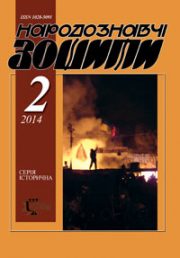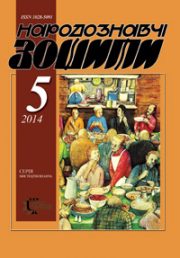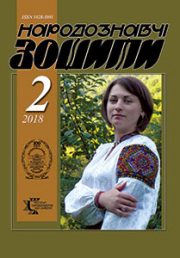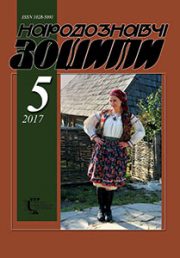The Ethnology Notebooks. 2019, № 5 (149), 1233—1238
UDK 811.161.2’373.2
DOI https://doi.org/10.15407/nz2019.05.1233
BASIC ISSUES OF MICROTOPONYMS CREATION
SOKIL-KLEPAR Nataliya
ORCID ID: https://orcid.org/0000-0002-4156-5978
Ph.D., Associate Professor
of the Department of Ukrainian Language,
Lviv Ivan Franko National University
1, Universytetska Str., 79001, Lviv, Ukraine
e-mail: nsokil@ukr.net
Abstract. Introduction: Microtoponyms are formed in accordance with the linguistic laws. These are recognized, extracted from the surrounding reality and nominated fragments of the environment. Geographical areas undergo verbalization only when they are of interest for a person, and this, in its turn, is the impetus for creating any name — be it an appellative name or propriative one. The scholars of onomastics mainly focused their attention on the nomination principles of settlements and persons. So far Ukrainian science lacks a separate profound study on the analysis of the grounds for microtoponyms creation. This is what makes this research topical. The main scientific method in the article is descriptive. Results: The elements that acquire importance in the environment nomination process are the following: a subject (the one who names the locus) and an object (geographical realia), someone who nominates and something that is nominated. The third important component is actually the means and methods of nomination (verbal form). Verbal expression of microtoponyms is subject to the peculiarities of creating this type of proper names. Microtoponyms are the units of secondary nomination, therefore, they frequently enter the onymic system as semantic derivatives (from appellative or from onymic ones: Verkh, Dvir; Romanykha, Kindrat). The important representants of local geographical microobjects are morphological method (Valylove, Volosianskyi), morphological and syntactic method (Hlubokyi, Dovhe), lexical and syntactic method (Zagora, Pidlis) as well as descriptive constructions (In Roveni; Velyke Pole, Na Poliani v Richtsi). Conclusion: Taking into account the aforementioned, one can conclude that microtoponymic nomination is closely related to two important factors: 1) landscape peculiarities of the area; 2) human factor. Nomination factors of geographical micro objects have both their specific features and similarities with other types of proper names.
Keywords: nomination, grounds, microtoponym, nomination method, derivative.
Received 3.10.2019
REFERENCES
Buchko, D.H., & Tkachova N.V. (2012). Dictionary of Ukrainian Onomastic Terminology. Kharkiv: Ranok-NT [in Ukrainian].
Selivanova, O.O. (2008). Modern linguistics: directions and problems. Poltava: Dovkillia-K [in Ukrainian].
Karpenko, O.Yu. (2006). Problems of cognitive onomastics. Odesa: Astroprynt [in Ukrainian].
Skliarenko, O., & Skliarenko, O. (2012). Typological onomastics: in 5 volumes (Vol. 1). Odesa: Astroprynt [in Ukrainian].
Molchanova, O.T. (1998). The role of ethnopsychology in the selection of onomasiological signs of motivation in the process of naming objects of habitat. Studia z filologii Polskiej і Sіowianskiej (Pp. 226—230) [in Russian].
Dictionary of the Ukrainian language: in 11 vol. (Vol. 3, p. 300). (1972). Kyiv: Naukova dumka [in Ukrainian].
Luchyk, V. (2011). On the peculiarities of the nomination in the place name of Ukraine. Visnyk Prykarpatskoho natsionalnoho universytetu. Filolohiia (Issue ХХІХ—ХХХІ, pp. 21—24) [in Ukrainian].
Buchko, D.H. (2009). Basic principles and methods of nomination of settlements in Halych land (according to the register of settlements since 1670). Ukrainska mova, 4, 41—51 [in Ukrainian].







